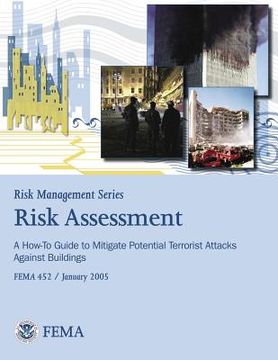Compartir
Risk Management Series: Risk Assessment - A How-To Guide to Mitigate Potential Terrorist Attacks Against Buildings (FEMA 452 / January 2005) (en Inglés)
Federal Emergency Management Agency
(Autor)
·
U. S. Department of Homeland Security
(Autor)
·
Createspace Independent Publishing Platform
· Tapa Blanda
Risk Management Series: Risk Assessment - A How-To Guide to Mitigate Potential Terrorist Attacks Against Buildings (FEMA 452 / January 2005) (en Inglés) - Agency, Federal Emergency Management ; Security, U. S. Department of Homeland
$ 43.90
$ 60.98
Ahorras: $ 17.08
Elige la lista en la que quieres agregar tu producto o crea una nueva lista
✓ Producto agregado correctamente a la lista de deseos.
Ir a Mis Listas
Origen: Estados Unidos
(Costos de importación incluídos en el precio)
Se enviará desde nuestra bodega entre el
Miércoles 17 de Julio y el
Miércoles 24 de Julio.
Lo recibirás en cualquier lugar de Internacional entre 1 y 3 días hábiles luego del envío.
Reseña del libro "Risk Management Series: Risk Assessment - A How-To Guide to Mitigate Potential Terrorist Attacks Against Buildings (FEMA 452 / January 2005) (en Inglés)"
The Federal Emergency Management Agency (FEMA) developed this Risk Assessment, A How-To Guide to Mitigate Potential Terrorist Attacks Against Buildings, to provide a clear, flexible, and comprehensive methodology to prepare a risk assessment. The intended audience includes the building sciences community of architects and engineers working for private institutions, building owners/operators/managers, and State and local government officials working in the building sciences community. The objective of this How-To Guide is to outline methods for identifying the critical assets and functions within buildings, determining the threats to those assets, and assessing the vulnerabilities associated with those threats. Based on those considerations, the methods presented in this How-To Guide provide a means to assess the risk to the assets and to make risk-based decisions on how to mitigate those risks. The scope of the methods includes reducing physical damage to structural and non-structural components of buildings and related infrastructure, and reducing resultant casualties during conventional bomb attacks, as well as chemical, biological, and radiological (CBR) agents. This document is written as a How-To Guide. It presents five steps and multiple tasks within each step that will lead you through a process for conducting a risk assessment and selecting mitigation options. It discusses what information is required to conduct a risk assessment, how and where to obtain it, and how to use it to calculate a risk score against each selected threat. This is one of a series of publications that address security issues in high-population, private sector buildings. This document is a companion to the Reference Manual to Mitigate Potential Terrorist Attacks Against Buildings (FEMA 426) and the Building Design for Homeland Security Training Course (FEMA E155). This document also leverages information contained within the Primer for Design of Commercial Buildings to Mitigate Terrorist Attacks (FEMA 427). The primary use of this risk assessment methodology is for buildings, although it could be adapted for other types of critical infrastructure. The foundation of the risk assessment methodology presented in this document is based on the approach that was developed for the Department of Veterans Affairs (VA) through the National Institute for Building Sciences (NIBS). Over 150 buildings have been successfully assessed using this technique. The risk assessment methodology presented in this publication has been refined by FEMA for this audience. The purpose of this How-To Guide is to provide a methodology for risk assessment to the building sciences community working for private institutions. It is up to the decision-makers to decide which types of threats they wish to protect against and which mitigation options are feasible and cost-effective. This How-To Guide views as critical that a team created to assess a particular building will be composed of professionals capable of evaluating different parts of the building. They should be senior individuals who have a breadth and depth of experience in the areas of civil, electrical, and mechanical engineering; architecture; site planning and security engineering; and how security and antiterrorism considerations affect site and building design.

